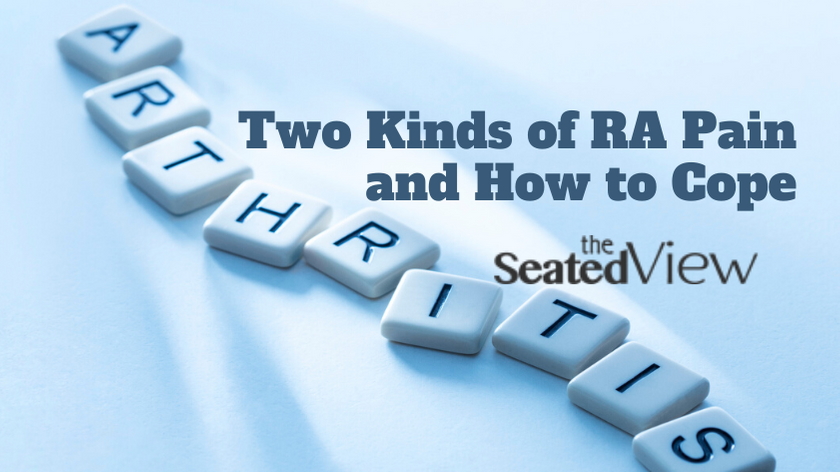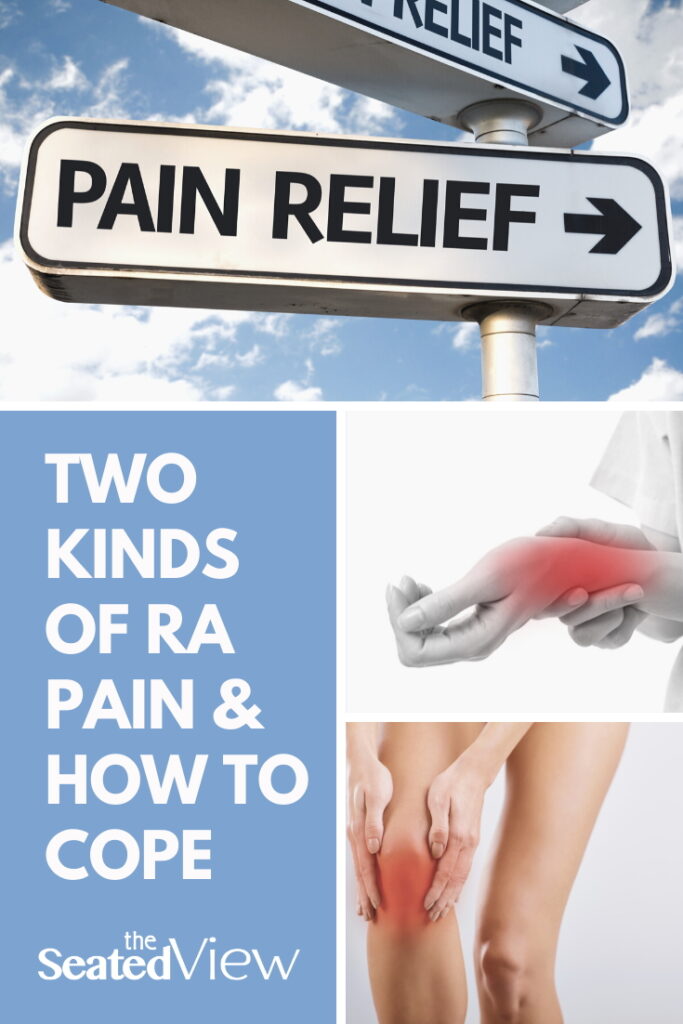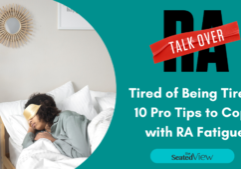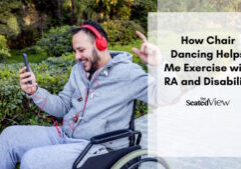Two Kinds of RA Pain and How to Cope

Pain is often one of the first symptoms of rheumatoid arthritis (RA) and may continue to play a leading role in your life with this condition. When you have RA, there are two general causes of pain: one is active RA inflammation and the other RA damage. I’ll take a look at both, as well as coping tools — both specific to each, as well as more general tips. A quick disclaimer — I don’t have a medical degree, but am sharing the information I’ve learned over half a century with this disease. Make sure you talk to doctors about what will work for your individual case and perhaps uses post to help you in that conversation.
The pain of RA inflammation
There is a unique quality to the pain of RA inflammation. It is a throb that keeps the rhythm of your heartbeat, an achy creaking that feels as if your joints are being pulled apart. Which I think makes sense, as your body tries to create room for the fluid that happens inside an inflamed joint. Your doctor might explain the differently (and likely more correctly), but that’s the visual that to me best explains how that particular pain feels.
Not surprisingly, the best method of dealing with this kind of pain is to get rid of the inflammation. That means disease modifying medication, such as Biologics, methotrexate, and other DMARDs (disease modifying antirheumatic drugs).
These drugs can take a while to work, as much as three months or more. While you wait for them to kick in, attack the inflammation with other weapons. This can include steroids, either through a daily low dose of prednisone or steroid injections directly into the joints. No needle is ever fun and the idea of having one inserted into your joints is legitimately an awful concept. However, it can be incredibly helpful. As with so many other medical procedures, sometimes we have to put ourselves in situations that make us anxious in order to feel better.
Controlling the symptoms of inflammation can help while you wait for the meds attacking the cause to kick in. NSAIDs (nonsteroidal anti-inflammatory drugs) can beat down the inflammation to a point. Some people also find turmeric really useful — in many ways, it acts like an NSAID, including some of the potential side effects and drug interactions.
While you wait for these medications to kick in, there are a number of other ways to get more comfortable. One is splints, which can serve two purposes. A resting splint can give you support as you sleep, so you are not kept awake by the joints moving in the wrong way as you turn in bed. As well, a working splint can provide support while you do tasks that can put pressure on the joints — one example is the splints I use when out with my camera.
Other pain management tips can be effective for both types of RA pain — I’ll get to them in a minute.

The pain of RA damage
The reason we take the meds is to prevent damage. Without medication, RA will essentially eat the cartilage that provides a cushion between the bones that meet in a joint, leaving nothing but bone-on bone. This is extremely painful.
Pain medication can be a very important tool when you have severe RA damage. Although NSAIDs may be useful, at this point, opioids may be more effective. And we all know how difficult it is to get a prescription for opioids these days. A referral to a pain management specialist may be necessary, but try to find someone who uses a multidisciplinary approach, rather than just medication.
In severe cases of RA damage, surgery — especially joint replacement — can be the path back to living with much less pain and higher function. I had both hips replaced when I was 16 and I still remember waking up from the surgery and noticing the absence of that grinding pain in my hips. Joints fusion can also be an option and sometimes, the resulting lack of mobility can be outweighed by the lack of pain.
As with active RA, splits can also be an important tool, helping to keep the bones from grinding together. However, it may also lead to loss of range in the joint, so you have to use splints carefully. Steroid injections can also give some temporary relief.
Your pain management toolbox
When you have chronic pain, it’s common to use a variety of tips and tricks that together will have more of an impact on your pain than any one of them separately. For instance, using both DMARDs, painkillers and splints will get you further down the road towards manageable pain — or perhaps even just a bit of pain — than using just one of them.
All of us develop our individual toolboxes and although there is some overlap, exactly what’s in this stash will depend on what works best for you. Some people will buy a box or basket to keep everything in one place and easy to reach when needed. Usually, there are icepacks and heating pads (experiment to find out what works best for you). You might add medication for breakthrough pain (talk to your doctor), topical anti-inflammatories that you can rub onto the joints, such as Voltaren gel, splints, compression gloves or stockings, fingerless gloves and legwarmers to keep the area warm, and pillows for support. As well, you can also add things that help you cope emotionally, such as stuffed toy (not just for kids!), your favourite movie or book, a box of cookies — anything that makes you feel comforted.
I know you don’t want to talk about moving when you’re in a lot of pain, but… Gentle range of motion exercises can prevent your body from stiffening up and that famous phrase Motion is Lotion is actually true — moving helps to make it easier to move. If you’re really hurting, do it in a warm bath. As well, some form of exercise in general can strengthen muscles that support the joints, which can lower your pain. Talk to your doctor about a referral to a physiotherapist for tips on how to move without hurting yourself.
Finding out what will work best for use often a matter of trial and error, to be repeated over time. What your body needs might change, and new treatments come out on a regular basis. Make sure you have an ongoing conversation with your doctor about pain management, including asking if a referral to a pain management specialist might be in order. Certain alternative treatments may also be useful — fr instance, I’ve responded really well to acupuncture and massage. Explore as you wish, but do some research and verify that your practitioners are legit.
I grew up a time when there were no treatments and had to accept being in pain. This no longer has to happen — treating your RA early and aggressively is an important preventative measure. However, not everyone responds to medications currently available, or perhaps you already have the damage. In that case, you may have to adjust to living with some level of pain. The key is to make it manageable and to have the treatment and tools you need in order to keep the pain to adult or so you can get on with your life.
Tag: medication, pain, pain control, pain management, pain management toolbox, RA pain, rheumatoid, rheumatoid arthritis, surgery
3 Comments
Read More
Discover what else I've been writing about...
















Lene,
It does my heart good to hear abut different kinds of pain. For so long I thought pain was pain, but of course as you point out, that is not true. I appreciate the clear and insightful description.
I had a virtual appointment with my rheumatologist last week. I told her that my joints still hurt, but she said that my inflammation levels are low. Unfortunately, the biologics cannot reverse the damage caused by RA this blog post was just perfect for me. Thanks Lene
this blog post was just perfect for me. Thanks Lene
Great article